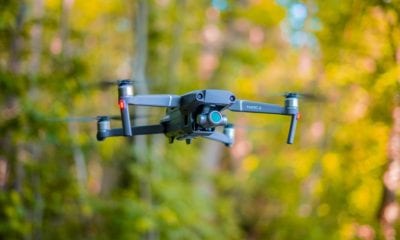Drones Prove Shark Numbers Less Than Feared
Research using drones to monitor and measure marine animals off the east coast of Australia has shown that indisputably, swimmers and surfers are far more likely to run into a dolphin than a shark.
Aerial footage gathered by the researchers from Australia’s Southern Cross University (SCU) over a two year period recorded large marine fauna residing off the coast of four exposed beaches in the north of New South Wales, including dolphins, rays, turtles, game fish – and sharks.
Shark attacks have been some cause for concern in the far north coastal region of the NSW – following a number of shark attacks in Ballina and Lennox Head, drones were deployed local councils to spot sharks.
But this time, the use of drones by researcher Prof. Brendan Kelaher from SCU’s National Marine Science Centre has shown that the dark spot lurking in northern NSW waters is more often than not going to be a dolphin.
“Our extensive data suggests it is up to 135 times more likely to be a dolphin than a shark. But if you are concerned, it’s best to get out of the water,” Professor Kelaher said in a statement to the press.
He points to the data he and his team have published this week in Marine & Freshwater Research, in which he notes that over 216 drone flights, 4388 individual large marine fauna were identified.
The most commonly seen creature were bottlenose dolphins (25.5% of sightings ) and cownose rays (19.9% of sightings).
Sharks, on the other hand – which comprised white, bull and other whaler sharks – made up less than 1% of identified marine creatures.
As well as contributing to knowledge about the distribution of the feared marine predators, Kelaher says that the team also captured footage of huge schools of rays numbering over 100 at a time, as well as whales feeding on bait balls and mesmerising inter-species chases between sharks, rays and dolphins.
“As well as contributing to beach safety, our drone program has been quantifying the diverse marine wildlife off our beaches,” he said.
“Our beaches provide habitat for amazing marine animals including dolphins, sharks, rays, turtles, seabirds, game fish and the occasional whale.
Professor Kelaher says ocean users should be assured by the results of the research, and he is impressed by the use of drone technology in his research.
“We do see potentially dangerous sharks in the shallows, but our data show they are much less common than people would have you believe.
“Our oceans are teeming with life and the fact that you can see dolphins regularly by just simply going to the beach is fantastic. We are really lucky to have such a wonderful marine environment on our doorstep.
“Further, the findings confirm that emerging drone technology can make a valuable contribution to the ecological information required to ensure the long-term sustainability of beach ecosystems.”
Citation: Kelaher Brendan P., Colefax Andrew P., Tagliafico Alejandro, Bishop Melanie J., Giles Anna, Butcher Paul A. (2019) Assessing variation in assemblages of large marine fauna off ocean beaches using drones. Marine and Freshwater Research, https://doi.org/10.1071/MF18375





















